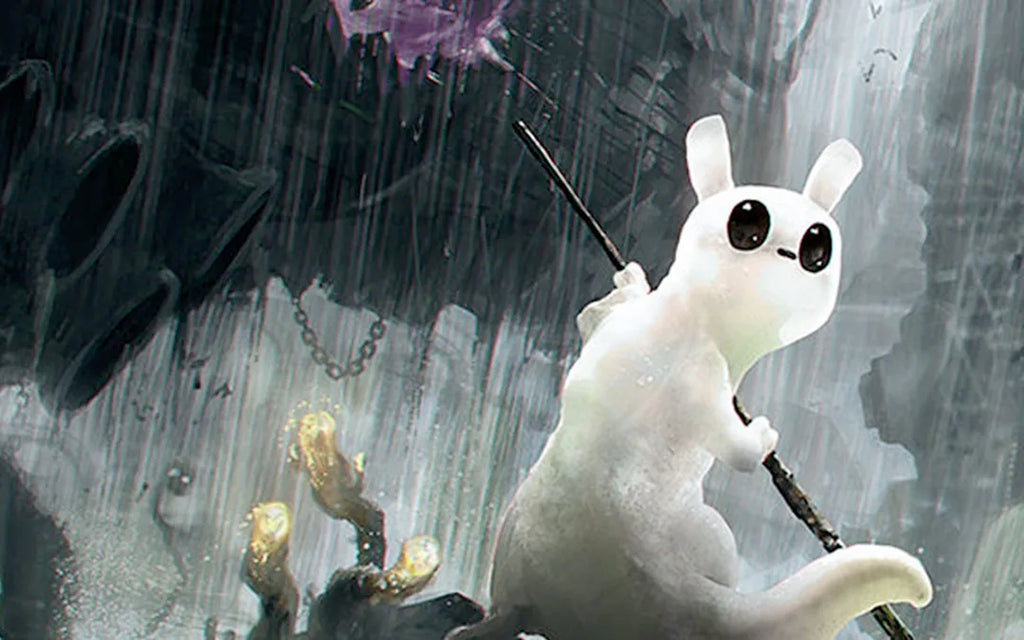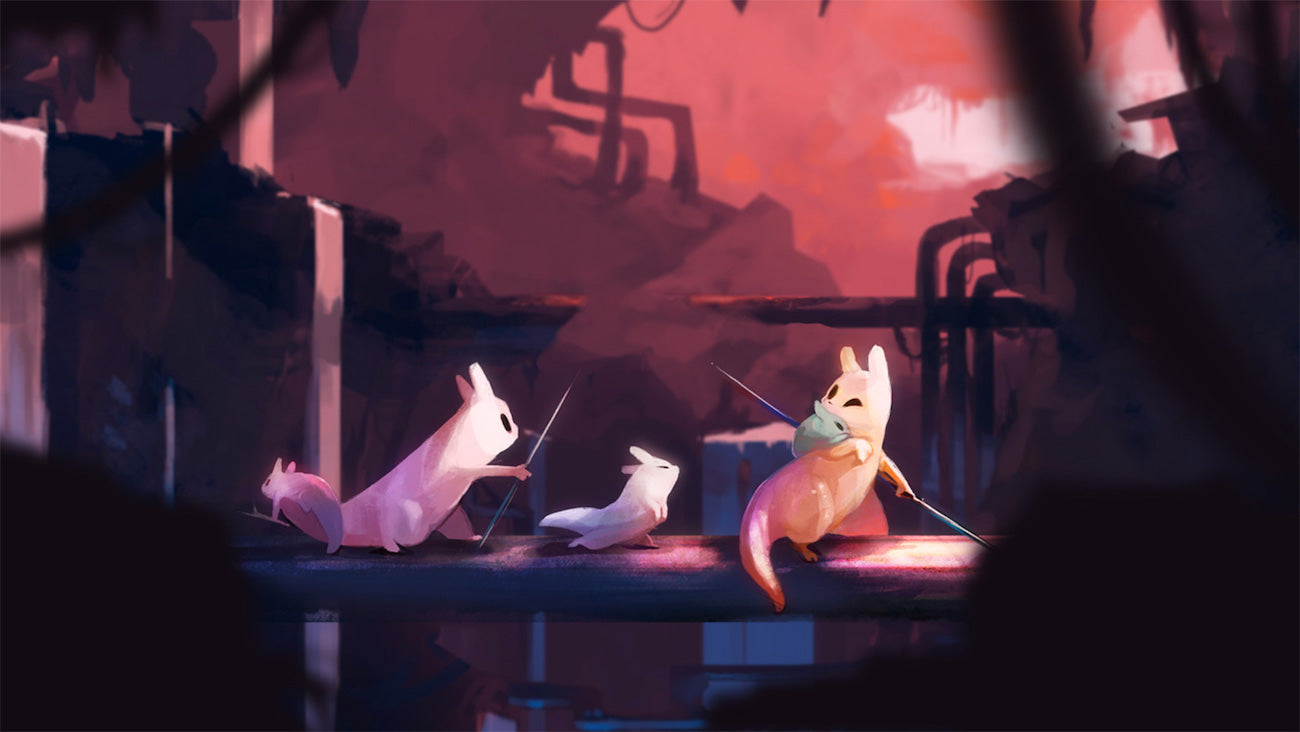

We explore the formation of the Videocult dev collaboration and the origins of Rain World's audio design.
By Jerry Jeriaska (The Ongaku)
The independently developed survival-platformer Rain World has captured the imagination of a far-flung online community. The concept arose from humble origins, as the solo project of Swedish developer Joar Jakobsson.
More recently, the post-apocalyptic landscape traversed by the game's nomadic hero, the slugcat, has expanded in size, as volunteer modders and sound designers were welcomed on board the "Downpour" expansion's team.
In 2012, screenshots of Joar's imagined ecosystem — a ruined industrial landscape populated by carnivorous fauna — made the rounds on the TIGSource forums. Among the readership perusing these early renderings of the sprite-based game, tentatively dubbed "Maze Runner," was a chiptune-influenced performer known as James Primate, part of a music act doing tours and live shows in the Cambridge, Massachusetts area.
Intrigued by the unique aesthetic, James found himself roused from sleep at night by the unsettling notion that something was about to go terribly wrong.

Bright Primate
Prior to discovering early glimpses of the "Maze Runner" prototype, James' ambitions as a touring musician met with a stroke of bad luck.
Just as the collaboration with his bandmates was beginning to gel, his drummer had a sudden epiphany, realizing that his true calling was to perform magic tricks. Soon after, his bass player quit, moving to Los Angeles to become a bartender.
"Before that we had been in a rock band, doing shows and touring," James recalls. "We put in a bunch of money and got a big name producer. We recorded albums. It was on college radio and doing well. Then the band broke up for literally no reason... That was it."
The only holdout was vocalist Lydia Esrig. Whittled down to half their former headcount, James and Lydia were left with the choice of either calling it quits, or coming up with some out-of-the-box solution to their sudden predicament.
"We had put in so much effort, so much money, blood, sweat and tears," he says of the crisis that summoned the band Bright Primate into existence. "It was just going to be me and Lydia. We trusted each other, so we set out as a duo."
James had been experimenting with notating tunes on a Nintendo Game Boy console, utilizing Nanoloop software, LSDJ, and other more obscure sequencing apps. There was a certain quality to the archaic brick-like hardware, out of place and repurposed, that fit the desperate tenor of the occasion.
"To give you a sense of it, our first show was at this little club that would have a Talk-Like-A-Pirate Day open mic night," he recalls. "That performer's set would end and someone from the audience would jump out of the pit, on stage, and they would be the next act. And the person on stage would get right back down into the audience. I think that informed how I view the artist and audience relationship."
Bright Primate at CNB Summer Tour 2010 (photo by Marjorie Becker - Chiptography)TIGSource
Bright Primate's disarming combination of live vocals and chiptune music gradually drew a crowd. It was an anarchic environment feeding on unpredictability.
The key factor that distinguished James and Lydia's act was their experience. They had toured and performed live shows, having hosted concert series in Boston with top artists. Bright Primate had both the appeal of an underdog, and the resilience of battle-tested pros.
"For me, I grew up with that form factor of a Game Boy in my hands," James says. "It was nice to be able to have that combination of playing video games and making music at the same time. It was a very comfortable feeling for me."
In an environment where game-inspired music was becoming increasingly recognized as an established genre, communities were forming between game developers and live performers. On TIGSource, James read threads posted by Derek Yu in the leadup to Spelunky's release and progress updates by Notch on the making of Minecraft. Jay Tholen posted an EP of conceptual pieces for a point-and-click adventure game he called "Dropsy."
The back-and-forth online was bleeding over into meatspace as well. "You're doing chiptune? We're doing a game. Let's talk about it," was the gist of many conversations, struck up at concert venues. Between them, James and Lydia were scoring dozens of indie game soundtracks. "We were like, 'We can do this on the side.'"
James Primate in 2017 (photo by Marjorie Becker - Chiptography)It was around that time that James encountered Joar's pitch for the platformer "Maze Runner," where the player controlled a scavenging elastic mammal. The protagonist progressed through the world, evading predators and seeking out rare sources of nourishment. A ticking clock required the slugcat to make haste to the next available hibernating chamber, before the poor creature was swept up in a deluge of rain.
Game development is protean thing. A good concept can be sabotaged through a series of ill-advised iterative add-ons, resulting in an end product that is a grotesque caricature of the foundational concept. Having previously found himself blindsided by a torrent of bad luck, James became preoccupied with the fear that outside of his control this game prototype would meet a similar fate.
The notion that "Maze Runner" was doomed troubled James' sleep, as if among the forums' members there lurked an evil doppelgänger, determined to sneak into Joar's private messages and infiltrate the project, wrecking the audio at every devious opportunity.
In his mind's eye, James saw slugcat leaping into the air, accompanied by the sound of a cartoonish "SPROING," flinging a spear into a hill of debris with a thunderous "BOINK."
"On the forum, I had been talking with Joar off and on," James says, "and I thought 'I have to do this myself!' I whipped up a ton of music. I think it was twelve tracks. I had the whole vision in my head immediately."
"I sent it to him, and he said, 'This is a lot of work. Why are you doing all this for free?'"
Source code
By the time Rain World secured funding through a successful Kickstarter campaign, Bright Primate's role had expanded beyond music composition. In contributing to the sound design, Lydia recorded snarls and squeaks for the carnivorous lizards and subterranean lantern mice. For the voice of Looks to the Moon, James designed an audio patch that he applied to her recordings, then sliced them up to give the audio recordings an uncanny robotic quality.
James also pitched in with level design with Joar's blessings—a decision that presaged a broader collaboration involving volunteer modders that would transpire further down the road. The game's punishing difficulty tended to divide prospective players into two camps. Those prone to complaints opted out, rage-quitting in frustration. However, those who were willing to soldier on, won over by the mystique of the world, began populating the fanbase.
"The things that wound up being the most contentious were people wanting plushies in a certain color," James says. "Those were the kind of criticisms on the Kickstarter forums."
One product of the close collaboration between the Swedish programmer and American audio designer was the integration of what came to be known as "threat music." "You were in the character's head," James says of the concept, "and as threats increased you would build that tension with audio somehow." What Joar came up with was a responsive audio system that correlated directly with the complex enemy AI.
For each region of the world, there were layers of sounds forming an alarming music composition that would be triggered selectively based on the imminence of danger. "It has its own system of weights and desires," James says of the enemy AI. "You can encounter a creature and it might just not be into you. It might be into doing something else, in which case the threat music would not build up to the degree that it otherwise would."
For a game where players could be expected to traverse the same maps dozens of times, the responsiveness of the AI and corresponding threat music made each cycle wholly unpredictable. The placement of creatures, for instance, was determined by a random seed, generated as slugcat awakened from a hibernating chamber at the start of each new cycle.
Blue fruit that was previously plucked would vanish, a region formerly empty was now populated with creatures. In the spot where the slugcat was captured by a lizard, a karma flower had sprouted. Upon entering any given map, the player was confronted with any number of shifting variables. Players could trade rare items with scavengers to get rare equipment and build rapport. Worms were inedible, but if fed to deadly predators they could be distracted or even befriended.
When Rain World was at last ready for launch on Steam, Joar deleted all the files that were not required to run the base game, and slugcat was now officially in the wild. "Steam has this funny thing where if you delete a folder but you don't do it in a certain way the files that aren't replaced stay there," notes James. "We cleared out the files we were using for testing, so we thought, and we pushed the game out."
As fate would have it, Joar soon found his inbox showered with praise for having included the entirety of the source code with the Steam release. "People were like, 'It's so awesome that you included the source code,'" James says. "'We can figure it out and make our own stuff.'"
TO BE CONTINUED IN PART 2, COMING SOON...
________________________________________________________
James Primate is a video game composer – brightprimate.bandcamp.com | Twitter @BRIGHTPRIMATE | Spotify artist page: open.spotify.com/artist/3hnNFBVerLqoj6p252UniW



